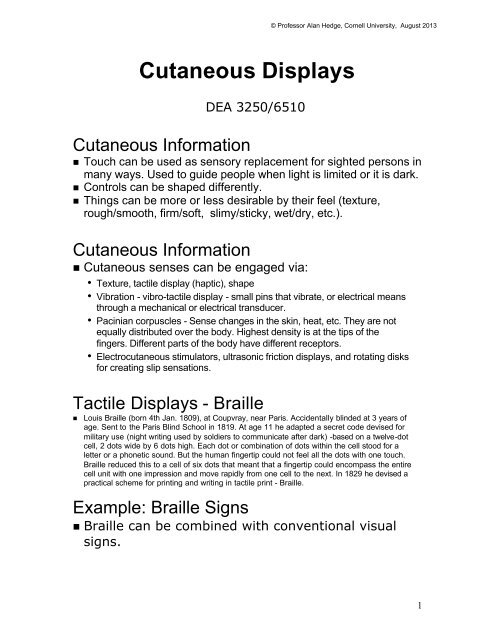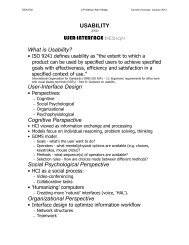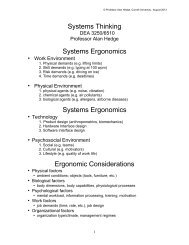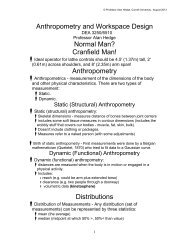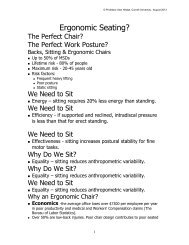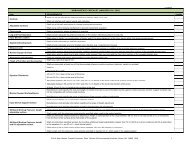Cutaneous Displays
Cutaneous Displays
Cutaneous Displays
You also want an ePaper? Increase the reach of your titles
YUMPU automatically turns print PDFs into web optimized ePapers that Google loves.
© Professor Alan Hedge, Cornell University, August 2013<strong>Cutaneous</strong> <strong>Displays</strong>DEA 3250/6510<strong>Cutaneous</strong> Information• Touch can be used as sensory replacement for sighted persons inmany ways. Used to guide people when light is limited or it is dark.• Controls can be shaped differently.• Things can be more or less desirable by their feel (texture,rough/smooth, firm/soft, slimy/sticky, wet/dry, etc.).<strong>Cutaneous</strong> Information• <strong>Cutaneous</strong> senses can be engaged via:• Texture, tactile display (haptic), shape• Vibration - vibro-tactile display - small pins that vibrate, or electrical meansthrough a mechanical or electrical transducer.• Pacinian corpuscles - Sense changes in the skin, heat, etc. They are notequally distributed over the body. Highest density is at the tips of thefingers. Different parts of the body have different receptors.• Electrocutaneous stimulators, ultrasonic friction displays, and rotating disksfor creating slip sensations.Tactile <strong>Displays</strong> - Braille• Louis Braille (born 4th Jan. 1809), at Coupvray, near Paris. Accidentally blinded at 3 years ofage. Sent to the Paris Blind School in 1819. At age 11 he adapted a secret code devised formilitary use (night writing used by soldiers to communicate after dark) -based on a twelve-dotcell, 2 dots wide by 6 dots high. Each dot or combination of dots within the cell stood for aletter or a phonetic sound. But the human fingertip could not feel all the dots with one touch.Braille reduced this to a cell of six dots that meant that a fingertip could encompass the entirecell unit with one impression and move rapidly from one cell to the next. In 1829 he devised apractical scheme for printing and writing in tactile print - Braille.Example: Braille Signs• Braille can be combined with conventional visualsigns.1
© Professor Alan Hedge, Cornell University, August 2013Olfactory <strong>Displays</strong>• Olfactory displays are used in some applications. Examples:• Natural gas is odorized with methyl mercaptan (CH 3 SH) for safety• Mine safety systems ("stench systems").• Odors can increase or decrease product desirability (e.g. new car odor,clean clothes odor).• Japanese companies introduce odors into offices; air fresheners addodorous chemicals into the air; some fragrances add human pheromones.• Scratch and sniff products.Taste <strong>Displays</strong>• Taste - This changes the desirability of products. Examplesinclude:• Medicines.• Toys.• Pen tops (so children will not swallow them).• Envelopes.2


